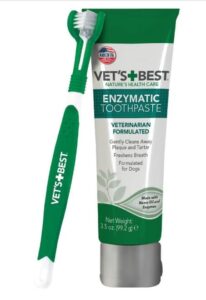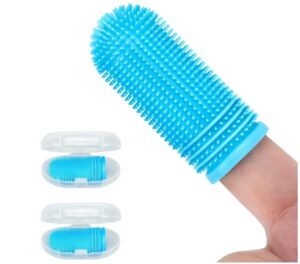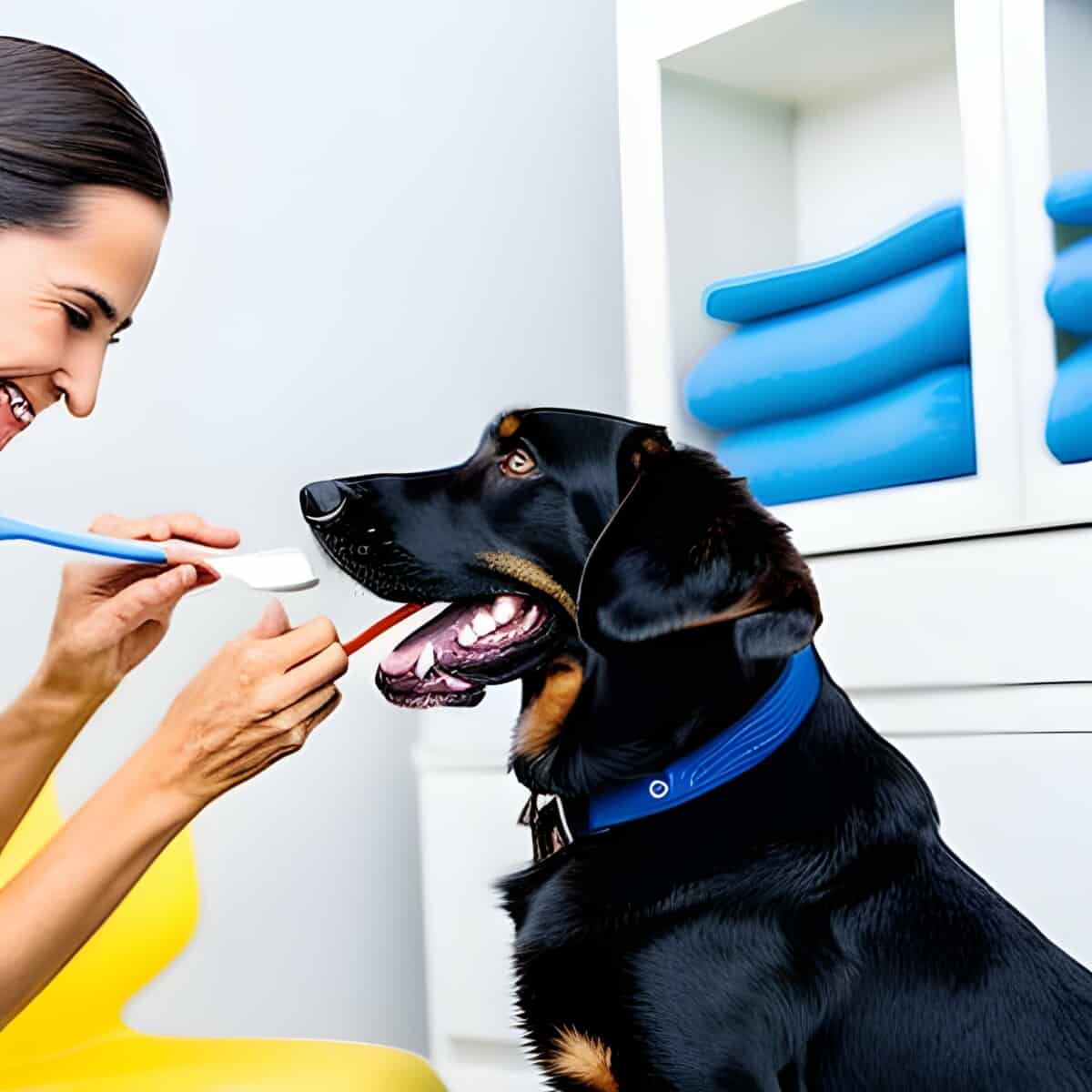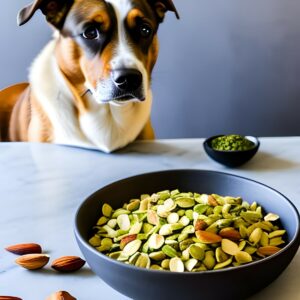I brush my dog’s teeth before the afternoon walk. She loves the walk but she loves our neighbor even more, he always has treats for her. So the reward for being a good girl during teeth brushing is a pleasant event.
But the process of getting to his point wasn’t as smooth.
Like most dogs, she wasn’t a fan of bruising, so I picked chews for dental cleaning. However, these types of teeth cleaning treats are great for maintaining oral hygiene – they can’t replace the actual teeth cleaning.
So we started slow.
First I introduced toothbrushes and started playing. She accepted the brush as a teeth-scratching toy.
Then I introduced the toothpaste by letting her lick it.
Our first attempt only included front teeth.
Then she was rewarded by trees and a walk.
The next time I cleaned the back teeth, and slowly, day by day she got used to it.
If you find a way to reward teeth cleaning the process becomes easy and enjoyable for you and your dog.
I will describe the process below to help you make teeth cleaning a fun process.
How to Brush Dogs Teeth: Table of Contents
1. Gather Teeth Brushing Suplays
It might be their least favorite thing in the world at the moment, but your dog’s dental health is a preventative measure for more serious health issues.
American Veterinary Dental Society states that by the age of three, 80% of dogs will have some degree of oral disease
The best is to start brushing dogs teeth in the puppy stage, but if you have a senior dog or adult dog there might be a few tricks you are going to have to learn.
Before you start with teeth bruising, it is a good idea to have all supplies on hand so you can introduce them to your dog. Let them get used to toothbrushes and toothpaste, let them smell them.
You will need:
- Toothbrush made for dogs – choose an angled and soft brush or a finger brush.
- Toothpaste made for dogs – choose your dog’s favorite flavor, our clients love the peanut butter taste, but there are also flavorless options available. Do not use human toothpaste, they are too harsh and can cause stomach issues.
- Prepare treats – you will need to reward your dog for each step.
- Toys and anything your dogs love and are already familiar with – this will help with stress and comfort.
My current choice is Vet’s Best Dog Toothbrush and Enzymatic Toothpaste Set. I find the veterinary formula to be gentle enough due to plant oils and aloe and an equally strong enzymatic cleaner for plaque. However, I rotate six different toothpastes, if you are looking for other options you can read about them here.

You can find it here.
Good toothbrush options are:
Wveroa 2 Pack Dog Toothbrush works great and it is comfortable for you and your dog.

You can browse it here.
Pet Toothbrush for Dogs is a double-sided soft brush I like, I use a larger side for front teeth and a smaller side for back teeth.

If you are interested to learn more and read reviews you can click here.
2. Prepare Your Dog for Teeth Brushing
Before you begin brushing your dog’s teeth, you’ll need to spend some time preparing them for the process. This will make the experience less stressful for both you and your pet.
- Start by holding their head gently and giving them a treat to help them relax.
- You can also try speaking to them in a calming tone to create a sense of ease and comfort.
- Show the toothbrush and let them sniff it.
- Try touching the mouth and immediately reward the dog. Try this as many times as they need to become comfortable with the sensation.
- Introduce the toothpaste, and let them sniff and taste it.
- Show enthusiasm and let your dog get excited.
- Please don’t force toothbrush in your dog’s mouth, they might think it is punishment.
- Move to the tongue: Once the dog is comfortable with the toothbrush in their mouth, you can begin gently brushing the tongue. Use gentle, circular motions to clean the surface of the tongue. Be careful not to apply too much pressure or cause any discomfort. Handling your dog’s tongue will help with instinctive gag and suffocation reflexes.
You can do this prior to the actual bruising. Make it a routine.
3. Brushing time
Some dogs may be nervous or anxious during teeth brushing, so go slow and be patient. If your dog becomes agitated or stressed, take a break and try again later.
4. Choose a quiet space with minimal distractions
Since this is going to be a routine, it is a good idea to pick a place where your dog feels safe and calm.
I brush my dog’s teeth in the living room. We made it into a ritual to sit on the floor, she likes to lay down.
5. Toothpaste application
Dip the bristles of the toothbrush into the toothpaste, making sure to use only a small amount.
You want just enough paste to clean your dog’s teeth, but not so much that they’ll start to foam in the mouth.
Let your dog smell and taste the toothpaste to get used to the flavor.
6. Gently Lift Your Dog’s Lip
Using your non-dominant hand, lift your dog’s lip to expose its teeth and gums.
Hold the toothbrush at a 45-degree angle to the teeth, ensuring that you brush both the outer and inner surfaces.
7. Brush the Teeth in Circular Motions
Using gentle circular motions, brush your dog’s teeth, focusing on one area at a time.
Start with the front teeth and work your way back, ensuring that you brush all surfaces of the teeth. Take your time, and don’t rush the process.
8. Brush the Inner Surfaces of the Teeth
After brushing the outer surfaces, gently brush the inner surfaces of your dog’s teeth using the same circular motion.
This is an area that is often neglected but is essential to prevent plaque buildup.
9. Reward Your Dog and Clean Up
After brushing, let your dog sniff the toothbrush and give them a lot of praise and a treat.
Then, clean the toothbrush and put it away for next time.
With patience and practice, your dog will soon get used to the teeth brushing process, and their dental health will improve.
Brushing alternatives
In practice, alternatives show some benefits.
If you prefer professional dental cleanings, brushing alternatives are a less stressful option for maintaining dental health in dogs.
However, if your dog chews on a dental treat too fast, there are no benefits in removing plaque.
Avoid bones at all costs. They are a danger to your dog’s mouth, throat, and stomach, plus they can break teeth.
- You can look into Supplements for dental health. They have health and oral health benefits.
- VOHC – Veterinary Oral Health Council-approved products
The Veterinary Oral Health Council (VOHC) is an organization that evaluates and approves oral health products for animals, particularly dogs and cats, which are designed to help reduce plaque and tartar on their teeth.
The VOHC authorizes the use of the VOHC Registered Seal on products that meet their standards for plaque and/or calculus reduction. This seal serves as an indication to veterinary professionals and pet owners that a product has been tested and proven effective by the VOHC.
VOHC-approved products include a variety of dental care items for pets, such as toothbrushes, dental chews, and water additives.
To qualify for VOHC approval, products undergo testing according to VOHC protocols.
The list of VOHC-approved dog products
Professional cleaning
Professional teeth cleaning in dogs requires anesthesia. It is the only complete teeth cleaning procedure and most dogs will have to have it at least once in their lifetime.
That’s why daily maintenance can help reduce any risk of putting your dog under anesthesia multiple times.
If your vet suggested professional cleaning there are ways to prepare your dog for anesthesia.
This should include fasting and at-home teeth cleaning.
The Importance of Dental Care for Dogs
Dental problems can lead to major health complications and even shorten your dog’s lifespan.
Signs that your dog needs a teeth cleaning are bad breath, yellowing of the teeth, teeth sensitivity, and tooth falling out.
Preventing Dental Diseases
Regular brushing removes plaque and tartar and can help prevent gingivitis and periodontal disease.
Certain breeds of dogs are more prone to dental problems than others. For example, small dog breeds such as Chihuahuas and Yorkshire Terriers are more susceptible to tooth decay and gum disease.
Similarly, dogs with flat faces, such as Pugs and Bulldogs, may have misaligned teeth that can lead to dental issues.
Improving Your Dog’s Breath
Bad breath, or halitosis, is a common problem in dogs.
Brushing your dog’s teeth can help to eliminate the bacteria that cause bad breath, resulting in a fresher-smelling mouth.
Bad breath can also be a sign of more serious health problems, such as kidney disease or diabetes.
If your dog has persistent bad breath, consult with your veterinarian to rule out any underlying health issues.
Extending Your Dog’s Lifespan
Poor dental health can lead to a host of health problems that may shorten your dog’s lifespan.
In addition to dental issues, poor oral health can also lead to heart, liver, and kidney disease. Regular brushing, along with other preventive measures, can help prevent oral disease and keep your dog healthy and happy for longer.
Dental care is just one aspect of your dog’s overall health care. Regular exercise, a healthy diet, and routine veterinary checkups are also essential in ensuring a long and healthy life for your furry companion.
A little effort now can go a long way in ensuring a longer, healthier life for your furry companion. So, make sure to prioritize your dog’s dental health and work with your veterinarian to develop a comprehensive health plan that meets all of their needs.
Vet Q$A
Q: Are you supposed to brush your dog’s teeth?
A: Yes, Bruising prevents oral issues, and kidney and pancreas issues.
Q: Is it too late to brush dogs’ teeth?
A: No. Opposed to the belief that senior dogs may be too old for teeth bruising and professional teeth cleaning, it is recommended procedure to prevent oral and overall health issues.
New techniques are lowering the risk of complications from anesthesia. We have a full article on this topic. Read our: “Is my dog too old for teeth cleaning” article.
Q: Do carrots clean dogs’ teeth?
Carrots are often included in discussions about dental health. They provide a crunchy texture that can help clean teeth during chewing.
However, carrots should make up only a small portion of a dog’s daily calorie intake to avoid excessive sugar consumption.
Q: How often to brush dog’s teeth?
A: American Veterinary Medical Association (AVMA) suggests, and we agree, that daily brushing gives the best results.
However, brushing a few times a week can still be effective for maintaining dental hygiene in dogs, especially while they are getting used to it, and in combination with the bruising alternatives mentioned earlier.
Q: What fruits clean dogs’ teeth?
A: When it comes to fruit, it is important to note that while some fruits can offer certain dental benefits, they should be given in moderation as part of a balanced diet.
Apples: Apples are known for their crunchiness, which can help remove plaque and tartar during chewing. They also contain malic acid, which may contribute to fresher breath in dogs.
Fruits alone should not be the sole method for cleaning dogs’ teeth.
The Veterinary Oral Health Council (VOHC), an organization of veterinary dentists and dental scientists, considers toothbrushing as the “gold standard” for at-home dental care for pets.
Regular toothbrushing with pet-safe toothpaste, appropriate chew toys, and professional dental cleanings performed by a veterinarian under anesthesia are essential for maintaining good dental hygiene in dogs
Q: Does raw meat clean dogs teeth?
A: As a responsible veterinarian, I would recommend discussing your dog’s dental health and diet with your veterinarian. They can provide you with personalized advice based on your dog’s specific needs, health status, and the latest research findings.
It’s important to consider the potential risks and benefits associated with raw meat feeding and make an informed decision in the best interest of your pet’s overall health and well-being.
Our nutrition guide could answer some specific questions.
Q: Is baking soda good for brushing dogs’ teeth?
A: No, baking soda upsets dogs’ stomachs and can disrupt the acid balance in the mouth and stomach.
My Senior Paws is a participant in the Amazon Services LLC Associates Program, an affiliate advertising program designed to provide a means for sites to earn advertising fees by advertising and linking to Amazon.com. We also participate in other affiliate programs which compensate us for referring traffic.




